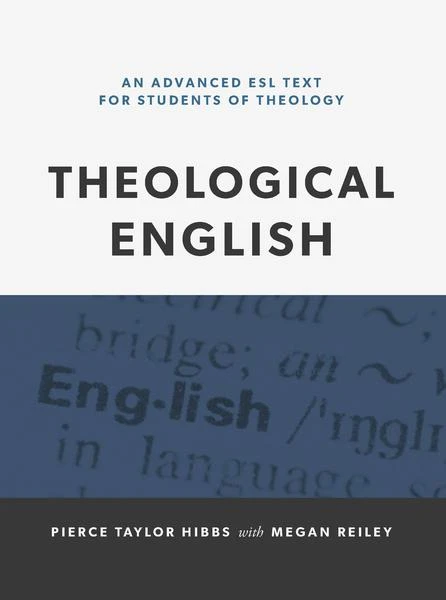
Pierce Taylor Hibbs with Megan Reiley
Reviewed by: Martha Wagar Wright
Theological English: An Advanced ESL Text for Students of Theology, by Pierce Taylor Hibbs with Megan Reiley. P&R, 2018. Hardcover, 376 pages, $41.88 (Amazon). Reviewed by OPC member Martha Wagar Wright.
It is a joy to find a beautifully crafted text for English as a Second Language which takes the best of current understandings of language acquisition and applies it with creativity and compassion to practical and accessible instruction. In Theological English, we see at every turn that authors Hibbs and Reiley have given great consideration to the needs and experience of students in demanding seminary programs like that of Westminster Theological Seminary, where they work.
Each chapter contains a well-thought-through arrangement of readings, exercises, grammar, and even practical application activities. The authors clearly demonstrate a deep understanding of communicative competence and second-language acquisition theory, weaving together goals in theology, reading, vocabulary, and grammar, and even scaffolding instruction from spoken to written, less known to better known.
Chapters begin with thought-provoking quotes from well-regarded writers and theologians, followed by a clear list of lesson goals, an introduction to the reading, and then discussion questions, background to the reading, and pre-reading questions, all of which are excellent in preparing students to undertake these very challenging reading passages. Many English language learners will have come from cultures where oral discussion has played a greater role in their education than written work, and this gives them the opportunity to enter into thinking about these profound texts in a manner that is more familiar. For other learners whose education has been largely written in their home country, oral discussions with native speakers are tremendously helpful in their language acquisition as well.
The readings include passages by Cornelius Van Til, John Frame, Greg Bahnsen, Vern Poythress, John Calvin, D. A. Carson, Edmund Clowney, and too many more to list here, and are annotated so that learners can identify key points and critical vocabulary, and notes build from chapter to chapter as well. These carefully curated readings are then followed by a large variety of exercises and activities: these include written tasks that focus on comprehension and vocabulary, specific grammar lessons related to the main reading, then activities that include not only writing but even practical application to real life. One that struck me as just perfect for students I have taught in East Africa was the activity that began, “Imagine that a close relative of yours asks you what you have been studying in seminary. . . . Your relative asks, ‘What have you learned so far?’” I could imagine my students at African Bible University in Kampala beaming when they read this assignment, and really learning how to say, write, and analyze their responses in this activity—and even putting the exercise into practice, the next time they went to see their family in the village! The lessons teach practical strategies for dealing with these difficult readings and ways of writing, such as clear steps for finding grammatical forms like pronoun referents.
Another particularly good lesson was on an extremely challenging type of writing—paraphrasing, which is for many if not most students from overseas a new and even disturbing task, since they have been schooled in memorization and repetition. The authors go to great lengths to model by example, provide ample practice in skills on both micro- and macro-linguistic levels, as well as suitable feedback, both in the chapter explanations and answer key. These are all the elements critical to language acquisition, especially at higher levels for students who come from many different backgrounds—some who have a long way to go in reaching the level of English comprehension and production they need to gain the greatest benefit from an advanced seminary program.
The result is a superb textbook that is, while most definitely challenging, very easy to follow and use, both for instructors and students. Indeed, I would highly recommend this text even to a wide variety of people who might want to know about or are considering seminary education—including instructors who need to be more aware of what their non-native learners may not know. Native speakers of English who have not had a rigorous academic education might also want to use this book to be sure that their vocabulary, grammar, and writing skills are up to the task of seminary education.
Hibbs and Reiley are to be applauded for their tremendously thorough work in helping to prepare many brothers and sisters for kingdom work worldwide. I will be eagerly looking forward to an edition for our Bible college students overseas next.
April 27, 2025
The Devoted Mind: Seeking God’s Face in a World of Distraction
April 20, 2025
April 13, 2025
Suffering: God’s Purpose in Our Pain
April 06, 2025
Sunday Matters: 52 Devotionals to Prepare Your Heart for Church
March 30, 2025
On the Trail with a Missionary
March 23, 2025
Midnight Mercies: Walking with God Through Depression in Motherhood
March 16, 2025
© 2025 The Orthodox Presbyterian Church